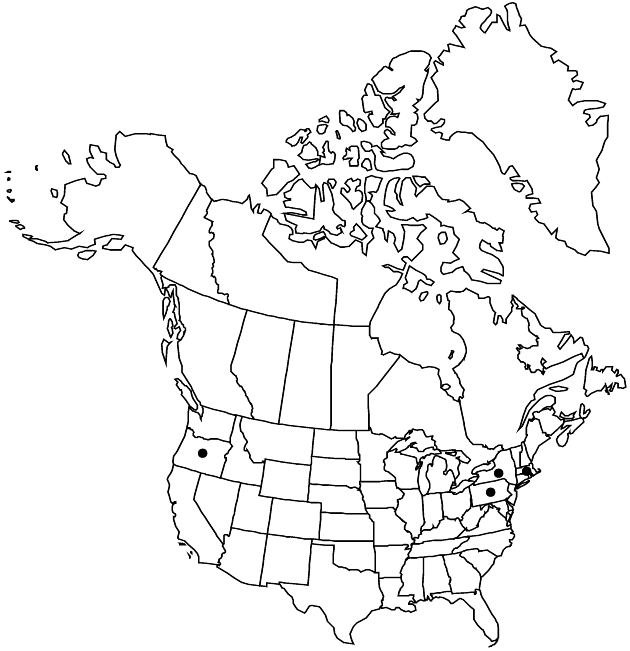Difference between revisions of "Logfia minima"
Fl. Belg., 68. 1827.
FNA>Volume Importer |
imported>Volume Importer |
||
| (2 intermediate revisions by 2 users not shown) | |||
| Line 8: | Line 8: | ||
}} | }} | ||
|common_names=Little cottonrose;cotonnière naine | |common_names=Little cottonrose;cotonnière naine | ||
| + | |special_status={{Treatment/ID/Special_status | ||
| + | |code=I | ||
| + | |label=Introduced | ||
| + | }} | ||
|basionyms={{Treatment/ID/Basionym | |basionyms={{Treatment/ID/Basionym | ||
|name=Gnaphalium minimum | |name=Gnaphalium minimum | ||
| Line 38: | Line 42: | ||
|elevation=0–400 m | |elevation=0–400 m | ||
|distribution=Mass.;N.Y.;Oreg.;Pa.;Eurasia. | |distribution=Mass.;N.Y.;Oreg.;Pa.;Eurasia. | ||
| + | |introduced=true | ||
|discussion=<p>Reports of <i>Logfia minima</i> from British Columbia and Washington have not been confirmed by me. A report from California was erroneous. The earliest known specimen from the flora area came from Girard Point, Pennsylvania, in 1878.</p> | |discussion=<p>Reports of <i>Logfia minima</i> from British Columbia and Washington have not been confirmed by me. A report from California was erroneous. The earliest known specimen from the flora area came from Girard Point, Pennsylvania, in 1878.</p> | ||
|tables= | |tables= | ||
| Line 61: | Line 66: | ||
|publication title=Fl. Belg., | |publication title=Fl. Belg., | ||
|publication year=1827 | |publication year=1827 | ||
| − | |special status= | + | |special status=Introduced |
| − | |source xml=https:// | + | |source xml=https://bitbucket.org/aafc-mbb/fna-data-curation/src/2e0870ddd59836b60bcf96646a41e87ea5a5943a/coarse_grained_fna_xml/V19-20-21/V19_739.xml |
|tribe=Asteraceae tribe Gnaphalieae | |tribe=Asteraceae tribe Gnaphalieae | ||
|genus=Logfia | |genus=Logfia | ||
Latest revision as of 19:55, 5 November 2020
Plants 2–20[–30] cm. Stems 1, ± erect, or 2–5, ascending to spreading; branches leafy between proximal forks, remaining grayish, arachnoid-sericeous. Leaves narrowly elliptic to narrowly ovate, largest 7–10(–12) × 1–1.5(–2) mm, pliant; longest capitular leaves 0.8–1.5 times head heights, acute. Heads in glomerules of 3–7 in mostly dichasiiform, sometimes racemiform or paniculiform arrays, ± pyriform, largest 3–3.5 × 2 mm. Phyllaries usually 5, equal, ± like paleae. Receptacles ± fungiform, mostly 0.3–0.4 mm, heights 0.4–0.6 times diams. Pistillate paleae (except innermost) 8–12 in 1–2 series, ± vertically ranked, saccate, inflexed 70–90° proximally, gibbous, ± galeate, longest 2.6–3.1 mm, distal 15–30% of lengths glabrous abaxially; bodies ± bony, ± terete; wings prominent. Innermost paleae ± 8, spreading in 2 series, pistillate. Pistillate florets: outer 8–12 epappose, inner 18–30+ pappose. Bisexual florets 3–5; corollas 1.6–2.1 mm, lobes mostly 4, brownish to yellowish. Cypselae: outer incurved, proximally ± horizontal, distally erect, compressed, 0.8–0.9 mm; inner papillate; pappi mostly of 13–16 bristles falling in 1s or 2s, 1.8–2.1 mm. 2n = 28 (Byelorussia, former Czechoslovakia, Germany)
Phenology: Flowering and fruiting Jun–Aug.
Habitat: Ballast dumps (probably temporary), sometimes open disturbed sites away from coast
Elevation: 0–400 m
Distribution

Introduced; Mass., N.Y., Oreg., Pa., Eurasia.
Discussion
Reports of Logfia minima from British Columbia and Washington have not been confirmed by me. A report from California was erroneous. The earliest known specimen from the flora area came from Girard Point, Pennsylvania, in 1878.
Selected References
None.